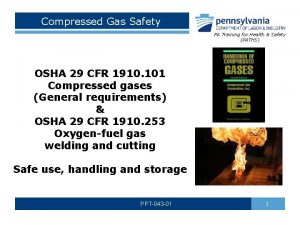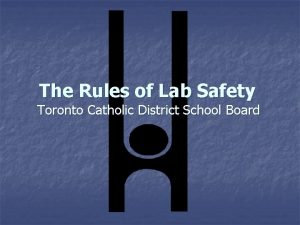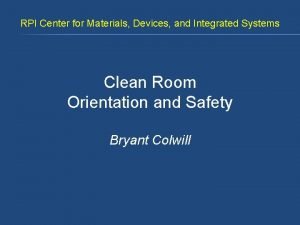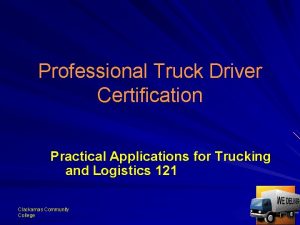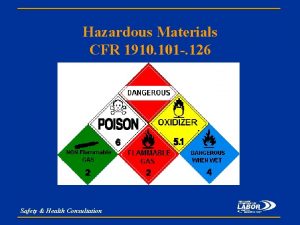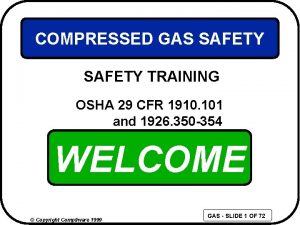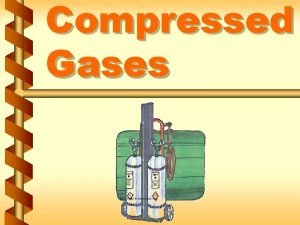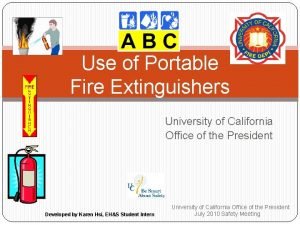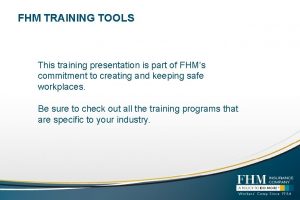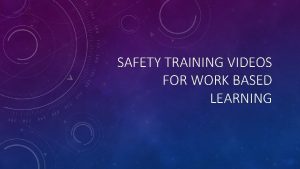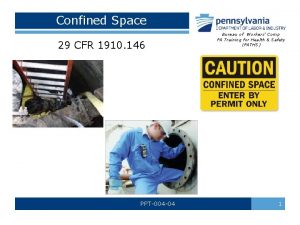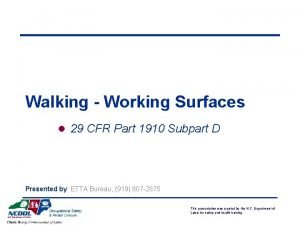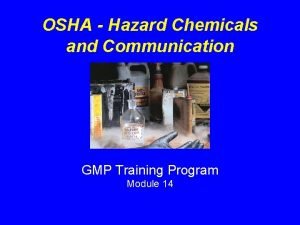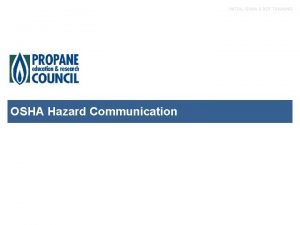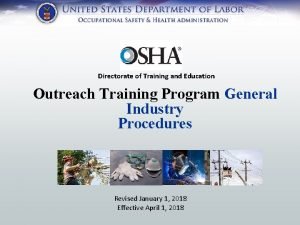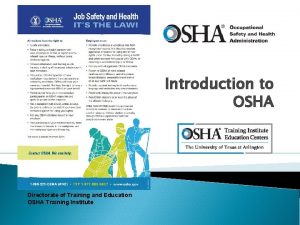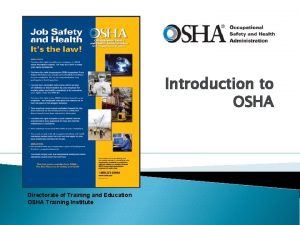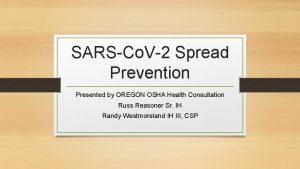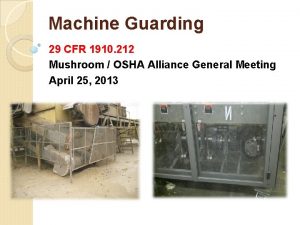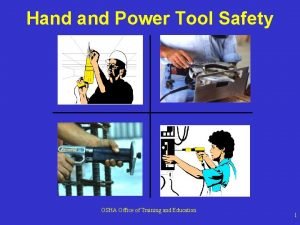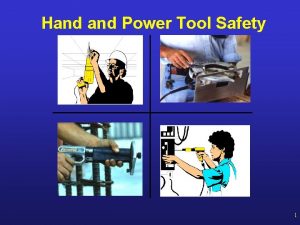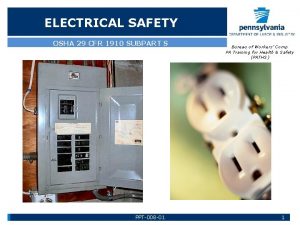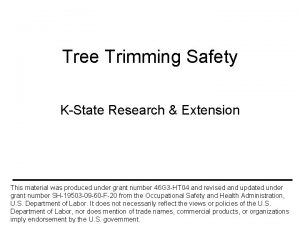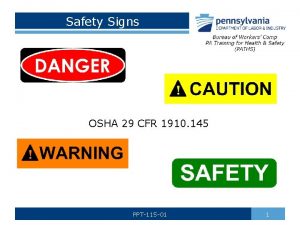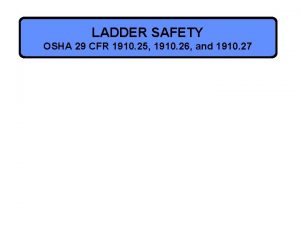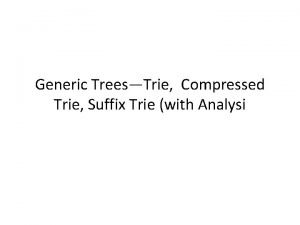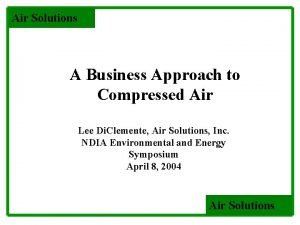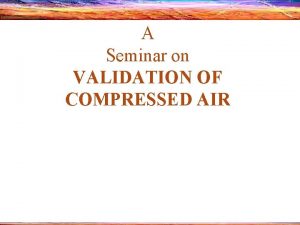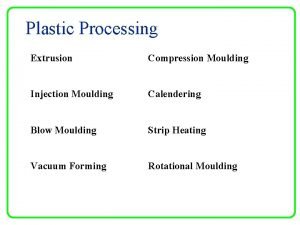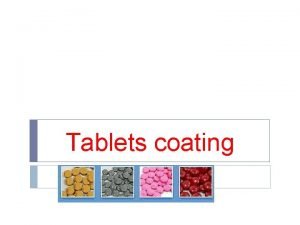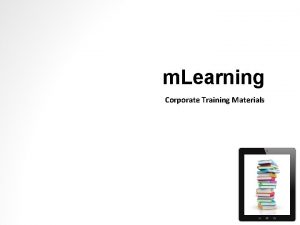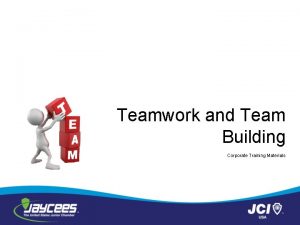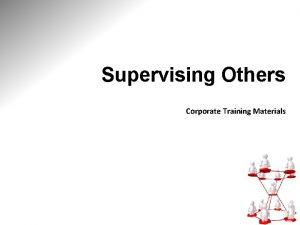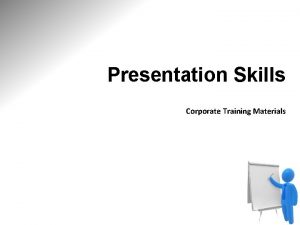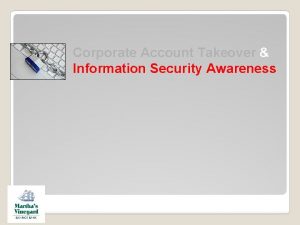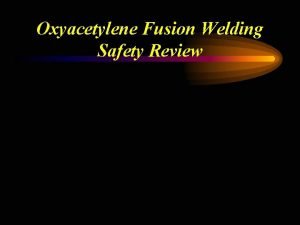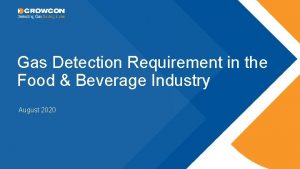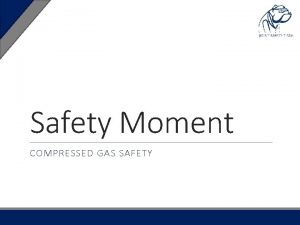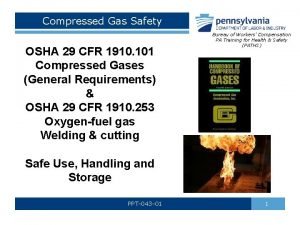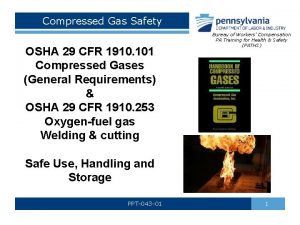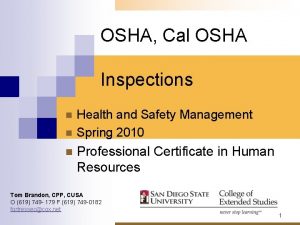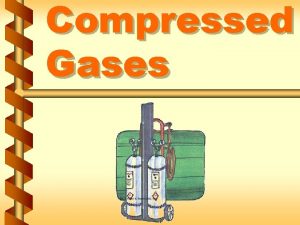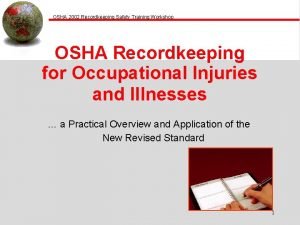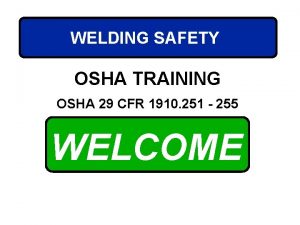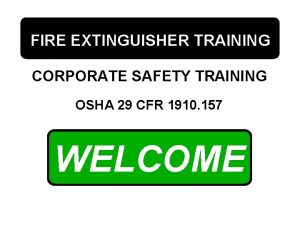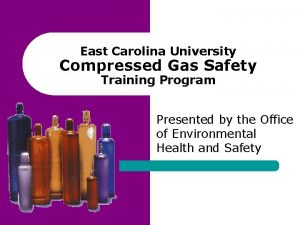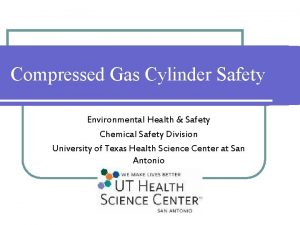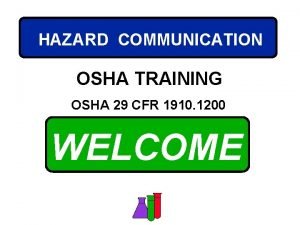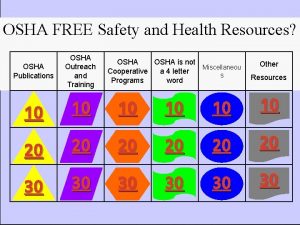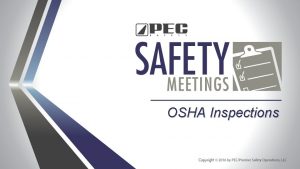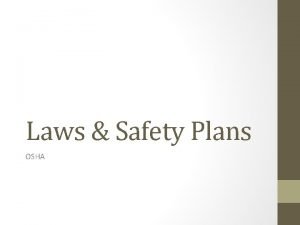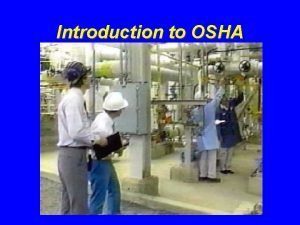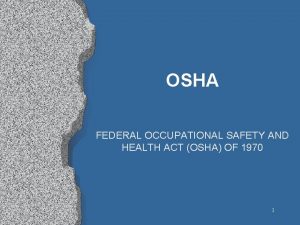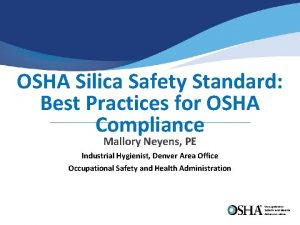COMPRESSED GAS SAFETY CORPORATE SAFETY TRAINING OSHA 29

































































- Slides: 65

COMPRESSED GAS SAFETY CORPORATE SAFETY TRAINING OSHA 29 CFR 1910. 101 WELCOME

COURSE OBJECTIVES þ Discuss Compressed Gas Program Requirements. þ Discuss Safety Inspection Requirements. þ Discuss The Types of Compressed Gases. þ Discuss Properties of Compressed Gases. þ Discuss Basic Skills in Hazard Recognition & Control. þ Discuss OSHA’s Requirements for Gas Safety. þ Discuss the Compressed Gas Association’s involvement. þ Discuss Use, Storage and Maintenance Requirements.

BASIS FOR THIS COURSE þ Employers are Responsible for Compressed Gas Safety. þ Compressed Gases Contain a Variety of Hazards. þ Compressed Gases are Maintained Under High Pressure. þ Compressed Gases are Extremely Hazardous þ Training Greatly Lessens the Probability of Disaster. þ This Training Helps Improve: ü ü Safety Morale Productivity Employee well-being

COURSE ATTENDEES þ Gas Users þ Safety Committees þ Purchasing Agents þ Department Managers þ First Line Supervisors þ Maintenance Managers þ Shipping and Receiving Employees þ Accident Investigation Team Members

FORWARD REGARDING COMPRESSED GAS SAFETY Know the gas you are using, or don’t use it! “Never let your name, and the word “dead” be used in the same sentence. ” Billy N. Ring, Fire Captain Dayton Regional HAZMAT Coordinator 27 Years Experience

APPLICABLE REGULATIONS 29 CFR - SAFETY AND HEALTH STANDARDS 1910 - INDUSTRIAL SAFETY 101 - COMPRESSED GASES (GENERAL)

CONSENSUS STANDARDS COMPRESSED GAS ASSOCIATION CGA P-1 - SAFE HANDLING OF COMPRESSED GASES - Over 100 Other CGA Safety Manuals DANGER COMPRESSED GAS STORAGE AREA

GENERAL PROGRAM REQUIREMENTS ALL EMPLOYERS MUST: þ Assign Responsibility þ Establish a Written Program þ Conduct Gas Safety Training þ Develop Safe-Use Procedures þ Conduct Work Area Inspections þ Maintain a Safe Work Environment þ Conduct Regular Program Evaluations þ Ensure Proper Storage and Maintenance

TRAINING REQUIREMENTS THE EMPLOYER MUST PROVIDE TRAINING: þ þ þ þ þ Properties of the Gases Being Handled. Explain Why a Particular Gas is Required. Conduct Training Prior to Job Assignment. Precautions to be Taken in Using Cylinders. Precautions to be Taken in Storing Cylinders. Precautions to be Taken in Moving Cylinders. Explain Proper Maintenance and Storage of Gases. Explain the Potential Hazards Associated with Gases. Explain The Nature, Extent and Effects of Gas Hazards.

RETRAINING REQUIREMENTS REQUIRED WHEN THERE IS A: þ þ þ New Hazard or Gas. Program Related Injury. Change in Job Assignment. New Hazard Control Methods. Failure in the Safety Procedures. Reason to Doubt Employee Proficiency.

TRAINING IS IMPORTANT A GOOD PROGRAM WILL HELP: þ Reduce injury and illness rates. þ Acceptance of high-turnover jobs. þ Workers feel better about their work. þ Reduce workers’ compensation costs. þ Elevate OSHA compliance to a higher level.

PROGRAM IMPLEMENTATION OF A COMPRESSED GAS SAFETY PROGRAM REQUIRES: þ DEDICATION þ PERSONAL INTEREST þ MANAGEMENT COMMITMENT NOTE: UNDERSTANDING AND SUPPORT FROM THE WORK FORCE IS ESSENTIAL, WITHOUT IT THE PROGRAM WILL FAIL!

PROGRAM IMPLEMENTATION Continued DEVELOPMENT SEQUENCE: þ þ þ þ þ DANGER Establish responsibility. COMPRESSED Conduct employee training. GAS STORAGE AREA Periodically review the program. Perform inspections and maintenance. Modify policies and rules as appropriate. Eliminate hazardous gases where possible. Establish a corporate policy and develop rules. Substitute nonhazardous gases where possible. Conduct a compressed gas safety survey of the facility. Provide protection where hazard elimination is not possible.

IMPLEMENTATION STRATEGY $ RECOGNITION @ EVALUATION 4 IMPLEMENTATION þ CONTROL

IMPLEMENTATION STRATEGY Continued þ RECOGNITION ASSESSMENT OF GAS HAZARDS: ü Known jobs/areas having gas usage. ü Jobs/areas with new equipment or processes. ü New jobs having little or no statistical injury data. ü Jobs/areas having had recent operational changes.

IMPLEMENTATION STRATEGY Continued $ RECOGNITION @ EVALUATION 4 IMPLEMENTATION þ CONTROL

IMPLEMENTATION STRATEGY Continued þ EVALUATION ü ü ü Facility audit data. Employee surveys. Accident investigations. Logs of employee complaints. Statistical evidence of known/potential hazards. Injury and illness data of known/potential hazards.

IMPLEMENTATION STRATEGY Continued $ RECOGNITION @ EVALUATION 4 IMPLEMENTATION þ CONTROL

IMPLEMENTATION STRATEGY Continued þ IMPLEMENTATION ü Written program. ü Training program. ü Employee involvement. ü Supervisor involvement. ü Corrective action program. ü Job hazard analysis program. ü Safety in purchasing (new gases, substitutes etc. )

IMPLEMENTATION STRATEGY Continued $ RECOGNITION @ EVALUATION 4 IMPLEMENTATION þ CONTROL

IMPLEMENTATION STRATEGY Continued þ CONTROL ü ü ü ü Periodic facility audits. Written program reviews. Employee feedback surveys. Job hazard analysis reviews. Recurrent training programs. Supervisor feedback surveys. Periodic statistical evaluations. Corrective action follow-up measures.

IMPLEMENTATION STRATEGY Continued þ CONTROL MEASURES CONSIDERATIONS: ü ü ü Capital improvement plan to eliminated hazards. Costs involved in purchasing substitutes gases. Length of time necessary for implementation. Level of urgency in implementation. Compatibility with existing processes or controls. Anticipated problems with employee use.

IMPLEMENTATION STRATEGY Continued þ PRIORITIZATION CONSIDERATIONS: ü ü ü Severity of injuries as a result of hazards. Consequences of an injury at the worksite. Likelihood that the operation will have an injury. The length of exposure to the hazard. Long-term effects of hazardous gas use.

THE SUPERVISOR’S ROLE þ CONSIDER THE FOLLOWING: 1. KNOW THE GASES YOU USE! 2. GET INVOLVED IN THE HAZARD ASSESSMENTS. 3. OBTAIN ASSISTANCE (IF NEEDED) FROM YOUR SUPPLIERS. 4. OBTAIN ASSISTANCE (IF NEEDED) FROM EXPERTS IN THE FIELD OF GAS SAFETY, CGA (703) 412 -0900. 5. COMPLETE THE PAPERWORK (WORK ORDERS, POLICY CHANGES, ETC. ) TO MAKE CORRECTIVE ACTIONS. 6. ATTEND THE SAME TRAINING AS YOUR WORKERS. 7. FOLLOW-UP ON THE ACTIONS YOU TOOK.

COMPRESSED GAS HAZARDS þ PRINCIPAL HAZARDS: ü ü ü ü Extremely High Pressure. Toxicity. Reactivity. Instability. Flammability. Extreme Low Temperature. Asphyxiation. Radioactivity.

COMPRESSED GAS HAZARDS Continued þ WHEN THINGS GO WRONG: ü ü ü ü Have Flown Over a Half Mile. Penetrated Brick Walls. Can Displace Oxygen in Extremely Large Areas. Can Oxygen-Enrich Extremely Large Areas. Can Spin and Ricochet Completely Out of Control. Can Immediately Freeze Exposed Skin. Can Explode With Tremendous Force. Can be Virtually Unstoppable.

COMPRESSED GAS HAZARDS Continued þ THE TYPICAL COMPRESSED GAS CYLINDER: ü ü ü ü 175 Pounds. 2, 000 to 2, 640 psig (some to 6, 000 psig). Wall Thickness of About 1/4 Inch. 57 Inches Tall. 9 Inches In Diameter. Easily Toppled. Easily Corroded. Devastatingly Hazardous.

BASIC SAFETY RULES I’LL GET THE RUST OFF OF THIS THING ONE WAY OR ANOTHER! KIDS DON’T TRY THIS AT HOME!

BASIC SAFETY RULES Continued þ THE BIG THREE: ü Oxidizers: Must not be used in contact with oils, greases or other hydrocarbons. ü Flammables: Must not be exposed to flames, sparks or arcs including static electricity, hot surfaces or oxidizers. ü Non. Flammables: Must not be allowed to displace air in confined work spaces so that there is insufficient oxygen for breathing.

BASIC SAFETY RULES Continued þ FILLING OF CYLINDERS: ü Cylinders may not be filled except by the supplier of the cylinder or with the supplier’s consent. ü Where filling is authorized it must be accomplished in strict accordance with DOT, OSHA and CGA regulations.

BASIC SAFETY RULES Continued þ CONTENT IDENTIFICATION: ü Never assume you know what it is! ü Assuming (with gases) gets you dead! ü Labels must be legible at all times. ü Labels may not be altered or removed. ü Labels may not be bypassed, ignored, or otherwise defeated. ü Labels must be understood by all. ü Nonlegible/missing labels must be reported.

BASIC SAFETY RULES Continued þ CONTENT IDENTIFICATION: Continued ü Labels and their means of attachment must withstand their normal operating environment. ü Labels may evoke a false sense of security, and their meaning needs to be understood. ü Labels must be securely attached to cylinders so that they cannot be inadvertently or accidentally detached during use. ü Each container must bear the proper label for the gas contained.

BASIC SAFETY RULES Continued þ PAINTING CONTAINERS: ü Containers may not be painted. ü Painting may cover cylinder defects. ü Containers showing signs of corrosion must be removed from service and returned to the supplier. ü Never rely solely on the cylinder color for identification.

BASIC SAFETY RULES Continued þ LEAKING AND DEFECTIVE CYLINDERS: ü Never underestimate the hazard! ü Notify co-workers of the hazard. ü Consider evacuation of the area. ü Evacuate to open air, up-wind or side-wind. ü Report the contents, location, situation. ü Begin role call to account for co-workers. ü Do not return to work until all-clear is given.

BASIC SAFETY RULES Continued þ CYLINDER USAGE REQUIREMENTS: ü Verify contents before transporting or using. ü Keep cylinder caps on until ready to connect. ü Keep valve caps on until ready to use. ü Never use as a door stop. ü Never underestimate the hazard.

BASIC SAFETY RULES Continued þ MOVEMENT OF COMPRESSED GAS CYLINDERS: ü Never handle roughly. ü Never use magnetic lifting devices. ü Never lift by valves or cylinder caps. ü Never roll, drag, or slide the cylinder. ü Always use a hand-truck, fork truck etc. ü Cradles, ropes, chains, or slings are prohibited from use unless lugs or lifting attachments are provided by the manufacturer.

BASIC SAFETY RULES Continued þ STORAGE REQUIREMENTS (GENERAL): ü ü ü ü ü “No Smoking” signs must be posted. The name of the gas must be posted. Specific hazards must be posted. Containers must be stored up right. Gases must be stored with like gases. Do not intermingle full and empty containers. The oldest material must be used first. Stored only on stable surfaces. Some gases must always be shaded from sun.

BASIC SAFETY RULES Continued þ STORAGE ROOMS (GENERAL): ü Must be dry. ü Must not exceed 125 F. ü Must be well ventilated. ü Should be protected from tampering. ü Local fire inspectors should evaluate. ü NFPA guidelines should be reviewed. ü Subsurface storage should be avoided. ü Should be of fire-resistive construction.

BASIC SAFETY RULES Continued þ STORAGE ROOMS (GENERAL): ü Cylinders - Must not impede emergency egress. - Cannot be located near exits. - Cannot be located near stairs. ü Must be secured to prevent toppling.

BASIC SAFETY RULES Continued þ OUTDOOR STORAGE (GENERAL): ü Bottoms must be protected from corrosion. ü Must be secured to prevent toppling. ü Must be shaded in extreme temperatures. ü Some gases must always be shaded from sun. ü Should be of fire-resistive construction. ü Should be protected from tampering. ü Local fire inspectors should evaluate. ü NFPA guidelines should be reviewed.

BASIC SAFETY RULES Continued þ NAME DANGER þ PRECAUTIONS þ RESTRAINED ABOVE MIDPOINT þ EMERGENCY & USE PROCEDURES þ AWAY FROM COMBUSTIBLES ACETYLENE NO SMOKING NO FUMAR GAS INSPECTION CHECKLIST 1 4 3

BASIC SAFETY RULES Continued þ GENERAL INSPECTION CRITERIA: INSPECT FOR: POSSIBLE RESULT: Dents Crevice Corrosion Bulges ARC/ Torch Burns Cuts, Gouges or Digs Corrosion Pitting Neck Defects Valve Ease-Of-Movement Valve Thread Serviceability Weakening of cylinder wall Decrease in wall thickness Leak or cylinder explosion Corrosion leading to leak Leak during operation

BASIC SAFETY RULES Continued þ PRE-OPERATION SAFETY RULES: ü If you’re not trained don’t touch it! ü Read the Material Safety Data Sheet before use. ü Ensure an “In Use” label is present. ü Ensure all labels/warnings are readable. ü Place upright on stable dry surface. ü Ensure cylinder is restrained above midpoint. ü Keep heat, flame, & electrical sources from gas. ü Use in accordance with established procedures.

BASIC SAFETY RULES Continued þ POST-OPERATION SAFETY RULES: ü If you’re not trained don’t touch it! ü Read the Material Safety Data Sheet. ü Ensure an “Empty” label is present. ü Close valve completely and cap cylinder. ü Remove from operation (established procedures). ü Transport cylinder using a handtruck. ü Place in “Empty Container” storage area. ü Ensure “Empty” label is readable.

STORAGE RULES STORAGE VARIES GREATLY, HERE A FEW EXAMPLES OF COMMON STORAGE REQUIREMENTS. ASK YOUR LOCAL FIRE INSPECTOR TO HELP YOU WITH YOUR SPECIFIC TYPES OF GASES.

STORAGE RULES Continued USE OLDEST STOCK FIRST! DANGER FULL CYLINDERS NO SMOKING! ACETYLENE DANGER 4 COMPRESSED GAS STORAGE AREA 1 3 GAS STORAGE CHECKLIST

STORAGE RULES Continued þ FULL CYLINDER STORAGE RULES: ü If you’re not trained don’t touch it! ü Read the Material Safety Data Sheet. ü Do not smoke. ü Mark cylinder with date of storage. ü Rotate oldest product to front and use first. ü Inspect cylinder for damage before storage. ü Store with like kind of gas.

STORAGE RULES Continued þ FULL CYLINDER STORAGE RULES: Continued ü Ensure all labels are readable. ü Ensure valve assembly is tightly capped. ü Ensure cylinder is restrained above midpoint. ü Store upright on stable dry surface. ü Keep electrical devices away from gas. ü Keep combustible materials away from gas. ü Keep heat, flame and ignition sources from gas. ü Never underestimate the hazard.

STORAGE RULES Continued þ EMPTY CYLINDER STORAGE RULES: ü If you’re not trained don’t touch it! ü Read the Material Safety Data Sheet. ü Do not smoke. ü Ensure the cylinder is empty. ü Ensure valve assembly is closed tightly. ü Ensure valve assembly is capped tightly. ü Inspect cylinder for damage before storage. ü Store with like kind of gas cylinders.

STORAGE RULES Continued þ EMPTY CYLINDER STORAGE RULES: Continued ü Ensure all labels are readable. ü Ensure cylinder is restrained above midpoint. ü Store upright on a stable dry surface. ü Keep electrical devices away from gas. ü Keep combustible materials away from gas. ü Keep heat and flame away from gas. ü Never underestimate the hazard.

SPECIFIC TYPES OF GASES THERE ARE HUNDREDS OF GASES USED IN INDUSTRY. HERE A FEW EXAMPLES OF COMMONLY USED GASES. ASK YOUR SUPPLIER TO HELP YOU WITH YOUR SPECIFIC TYPES OF GASES.

SPECIFIC TYPES OF GASES Continued þ OXYGEN (INCLUDING OXIDIZING GASES): ü ü ü ü ü Oxygen and oxidizers can be deadly. Cleanliness is absolutely essential!!! Explosion results upon contact with hydrocarbons. Keep oil, grease, and other hydrocarbons away! Ensure process or system is compatible with oxygen. Assess compatibility of equipment and materials. Separate from combustible materials. Oxygen can “fuel enrich” permeable materials. Oxygen enriched materials burn tremendously.

SPECIFIC TYPES OF GASES Continued THE p. H of ACIDS AND BASES p. H IS THE NUMERICAL MEASURE OF ITS RELATIVE ACIDITY OR ALKALINITY. THE RANGE IS FROM 0 - 14 WITH A NEUTRAL LEVEL EXPRESSED AS A p. H OF 7. 0. p. H ABOVE 7. 0 - MORE ALKALINE OR BASIC. p. H BELOW 7. 0 - MORE ACIDIC.

SPECIFIC TYPES OF GASES Continued CHECK FOR COMPATIBILITY! LOW p. H ACID BASE HIGH p. H

SPECIFIC TYPES OF GASES Continued þ ACID & ALKALINE GASES: ü ü ü ü Avoid contact with all bodily routes of entry. Wear goggles and suitable skin protection. Consider effects on the respiratory tract. Long sleeves and trousers are mandatory. Open toed shoes or sneakers are prohibited. Gas masks/SCBA must be immediately available. SCBA must be used when the concentration could exceed the rating of the gas mask canister or if the gas could displace oxygen to below 19 percent.

SPECIFIC TYPES OF GASES Continued þ ACID & ALKALINE GASES: ü ü Continued Emergency showers/eyewashes must be available. Quantities on-site must be limited. Ventilation must be adequate in the work area. Common corrosive and toxic gases include: - Boron Trichloride - Chlorine Trifluoride - Iodine Pentafluoride - Sulfur Tetrafluoride - Bromine Trifluoride - Hydrogen Fluoride - Silicon Tetrafluoride - Tungsten Hexafluoride

SPECIFIC TYPES OF GASES Continued þ BHOPAL, INDIA: ü ü ü ü Over 2000 people died. Methyl isocyanate released. Occurred in December 1984. SARA Title III initially proposed as a result. The Union Carbide Facility was not unique. The accident could have occurred anywhere. Most were inhabitants in the area of the plant.

SPECIFIC TYPES OF GASES Continued þ HIGHLY TOXIC GASES: ü ü ü ü ü Remember Bhopal India! Training is critical. The specific hazards must be understood. Threshold Limit Values must be determined. Storage is critical and must be assessed. Ventilation is critical and must be assessed. Gas discharges must be scrubbed. Discharges must be neutralized. On-site quantities must be limited.

SPECIFIC TYPES OF GASES Continued þ HIGHLY TOXIC GASES: ü ü Continued Medical services should be pre-planned. Suppliers/manufacturers should be consulted. Emergency responders should consulted. Common highly toxic gases include: - Arsine - Bromine Trifluoride - Chlorine - Germane - Hydrogen Selenide - Nitric Oxide - Boron Trichloride - Bromine Pentafluoride - Fluorine - Hydrogen Cyanide - Hydrogen Sulfide - Phosgene

SPECIFIC TYPES OF GASES Continued þ CRYOGENIC LIQUEFIED GASES: ü ü ü ü ü In liquid form at relatively low pressures. Extremely low temperatures. Usually below - 238 F (- 150 C). Handled in heavily insulated containers. Insulated containers minimize evaporation. Properation of venting systems is essential. High expansion rate on vaporization. Can cause extreme bodily damage on contact. Full body protection must be utilized.

SPECIFIC TYPES OF GASES Continued þ CRYOGENIC LIQUEFIED GASES: Continued Oxygen Rate of Expansion 3 3 1 ft - 238 F 875 ft +65 F

SPECIFIC TYPES OF GASES Continued þ CRYOGENIC LIQUEFIED GASES: ü ü ü ü Continued Use only hardware designed for cryogenics. Pain is not immediate. Tissue solidifies over time. Blood circulation is arrested. Serious skin burns may result. Blood clots are highly probable. Skin highly vulnerable to infection. Flush with tepid water. LOX

SPECIFIC TYPES OF GASES Continued þ INERT GASES: ü ü Can displace oxygen leading to asphyxiation. SCBA or airline systems must be used. Oxygen content below 19 percent is dangerous. Common highly inert gases include: - Argon - Helium - Nitrogen - Carbon Dioxide - Neon - Xenon

SPECIFIC TYPES OF GASES Continued þ GENERAL SAFETY CONSIDERATIONS ü ü ü ü ü Don’t be afraid to ask people to wait! Limit conversation while using gases. Know that you could be seriously injured. Know that no one ever expected to get injured. Know that none of us is immune to injury. Know the safe procedures before starting work. Know the location of first aid kits. Avoid horseplay - don’t tolerate it from others. Think about going home in the same shape. Know your gas!

INSPECTION AND CARE OF GASES þ INSPECTION CONSIDERATIONS: ü ü ü ü Develop a detailed inspection policy. Document each inspection. Inspect all gases before issue or use. Tag as unusable, damaged cylinders. Inspect cylinders before each use (without exception). Separate damaged cylinders from serviceable cylinders. Consider the effects on gases stored for long periods. Remove damaged cylinders from service immediately.
 Compressed gas training powerpoint
Compressed gas training powerpoint Compressed gas hazard
Compressed gas hazard Rpicenter
Rpicenter Visual search
Visual search 29 cfr 1910 hazardous materials
29 cfr 1910 hazardous materials 29 cfr 1910 compressed gas cylinder storage
29 cfr 1910 compressed gas cylinder storage Compressed gas definition
Compressed gas definition Corporate finance and corporate governance
Corporate finance and corporate governance Safety care training
Safety care training Cal osha fire extinguisher requirements
Cal osha fire extinguisher requirements Osha yard tractor training
Osha yard tractor training Free osha training videos
Free osha training videos Osha fire extinguisher training powerpoint
Osha fire extinguisher training powerpoint Confined space training ppt
Confined space training ppt Cfr 1910
Cfr 1910 Osha hazard and ghs training regulation cfr 1910
Osha hazard and ghs training regulation cfr 1910 Osha hazard communication initial training
Osha hazard communication initial training Osha directorate of training and education
Osha directorate of training and education Osha directorate of training and education
Osha directorate of training and education Osha directorate of training and education
Osha directorate of training and education Osha safety pyramid
Osha safety pyramid Osha conveyor safety 1910
Osha conveyor safety 1910 Osha power tools must be fitted with guards and
Osha power tools must be fitted with guards and Osha homemade tools
Osha homemade tools 29 cfr 1910 subpart s
29 cfr 1910 subpart s 54 year old tree trimming accident
54 year old tree trimming accident Workplace safety signs and symbols ppt
Workplace safety signs and symbols ppt Osha robot safety
Osha robot safety 29 cfr 1910
29 cfr 1910 3-3 transforming linear functions
3-3 transforming linear functions A kind of rhythmic compressed language
A kind of rhythmic compressed language Pereopods
Pereopods Suffix trie example
Suffix trie example Compressed liquid water
Compressed liquid water Compressed air business
Compressed air business Compressed rvc foam
Compressed rvc foam Compressed air validation
Compressed air validation Wilkerson desiccant air dryer
Wilkerson desiccant air dryer Compressed air supercharging
Compressed air supercharging Hypodermic tablets administration
Hypodermic tablets administration Calendering moulding process
Calendering moulding process Sugar coating
Sugar coating Yuvpak compressed fractal image
Yuvpak compressed fractal image Stream processing engines
Stream processing engines Why is a gas easier to compress than a liquid or a solid?
Why is a gas easier to compress than a liquid or a solid? Compressed modernity definition
Compressed modernity definition Corporate training materials
Corporate training materials Teamwork training module
Teamwork training module Corporate training materials
Corporate training materials Corporate training materials reviews
Corporate training materials reviews Corporate account takeover training
Corporate account takeover training Ideal gas vs perfect gas
Ideal gas vs perfect gas An ideal gas is an imaginary gas
An ideal gas is an imaginary gas Differences between ideal gas and real gas
Differences between ideal gas and real gas Computational fluid dynamics
Computational fluid dynamics Conclusion bhopal gas tragedy
Conclusion bhopal gas tragedy Gas leaked in bhopal gas tragedy
Gas leaked in bhopal gas tragedy Gas reale e gas ideale
Gas reale e gas ideale Flue gas desulfurisation gas filter
Flue gas desulfurisation gas filter Poisonous gas leaked in bhopal gas tragedy
Poisonous gas leaked in bhopal gas tragedy Difference between ideal gas and real gas
Difference between ideal gas and real gas Contoh soal kinetika kimia orde 1
Contoh soal kinetika kimia orde 1 Gas exchange key events in gas exchange
Gas exchange key events in gas exchange Gas welding safety tips
Gas welding safety tips Food & beverage gas safety monitors
Food & beverage gas safety monitors Training is expensive without training it is more expensive
Training is expensive without training it is more expensive
